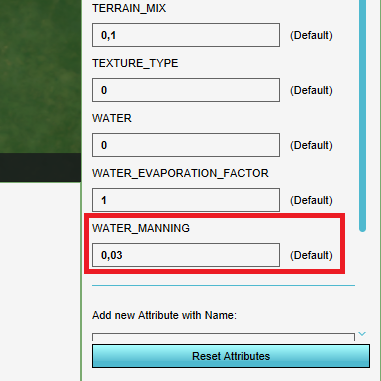Terrain water manning (Water Overlay): Difference between revisions
Jump to navigation
Jump to search
No edit summary |
No edit summary |
||
| Line 22: | Line 22: | ||
* [[Surface flow formula (Water Overlay)|Surface flow formula]] | * [[Surface flow formula (Water Overlay)|Surface flow formula]] | ||
* [[Surface model (Water_Overlay)|Surface model]] | * [[Surface model (Water_Overlay)|Surface model]] | ||
* [[Water_manning_(Water_Overlay)|Water manning]] | |||
* [[Manning_prequel_(Water_Overlay)|Manning prequel]] | * [[Manning_prequel_(Water_Overlay)|Manning prequel]] | ||
|references= | |references= | ||
Revision as of 14:46, 9 February 2022

| Icon | Attribute | Unit | Layer | Range | Description |
|---|---|---|---|---|---|
| |
WATER_MANNING | s/(m1/3) | Surface | The Gauckler–Manning coefficient of the terrain |
Terrains have an inherent "roughness", affecting the flow of water across their surface, which is expressed by the Gauckler–Manning coefficient or, in short, Manning's value (n).
Notes
- The manning value can alternatively be provided as a prequel.
- The default values for this attribute are derived from online accessible databases[1] and are readily adjusted by the user.
- If a construction is present on the terrain, the WATER_MANNING value of the construction is used instead.
- Only terrains of type 'surface' have an assigned WATER_MANNING.
See also
References
- ↑ WikiEngineer (2008-2011). Manning Roughness Coefficients. Retrieved from: http://wikiengineer.com/Water-Resources/ManningRoughnessCoefficients




